Can LED-Sized Terahertz Wave Generators and Detectors Transform Society?
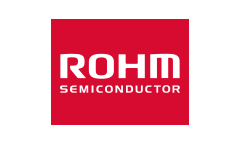
Exploring the potential of terahertz applications with cutting-edge Resonant Tunneling Diodes (Part 2)
While terahertz waves offer undeniable benefits, the high costs of development and uncertain path to commercialization are a deterrent for many engineers. At the same time, the potential applications might not seem compelling enough to warrant the substantial investment required for implementation. But what if there was an ultra-compact terahertz oscillator and detector that addresses these challenges and is already nearing practical application?
In this article, we will introduce the latest ultra-compact terahertz oscillator and detector currently being developed by ROHM while delving into the future possibilities of terahertz wave applications.
Contents
1. Practical Terahertz Applications using ROHM's Resonant Tunneling Diodes
2. Features of ROHM RTDs
a) Ultra-Compact
b) Low Power Consumption
c) Provides a Low-Cost Development Environment
d) Radio Law Compliance
e) Future Development Plans
3. ROHM’s Challenges: From Manufacturing to Creating Value
4. Pioneering the Final Frequency Frontier
1. Practical Terahertz Applications using ROHM's Resonant Tunneling Diodes
The biggest obstacle to the practical application of terahertz waves has been the lack of a compact, low-cost, commercially viable terahertz source. Existing terahertz wave sources used in research and development are often bulky and power-hungry, rendering them impractical for use in commercial applications.
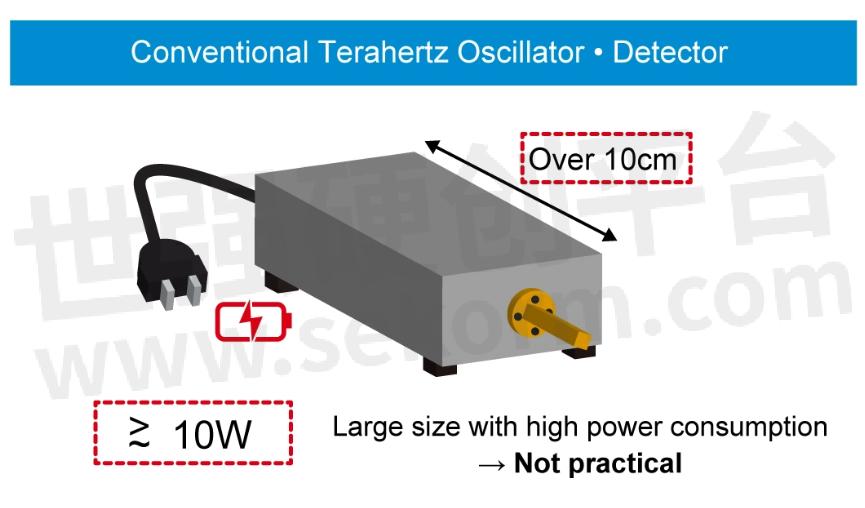
With the vision that developing an ultra-compact, low-power, easily integrable terahertz source could accelerate practical adoption, ROHM embarked on a decade-long journey of research and development. Collaborating with numerous universities and research institutions, including the Tokyo Institute of Technology, under the guidance of Professor Masahiro Asada and Professor Safumi Suzuki, ROHM finally succeeding in developing an in-house device capable of efficiently generating and detecting terahertz waves. This led to the creation of the Resonant Tunneling Diode (RTD), an ultra-compact, low-power terahertz oscillator and detector the size of an LED.
2. Features of ROHM's RTD
a) Ultra-Compact
ROHM’s RTD stands out for its revolutionary small size, defying traditional expectations for terahertz oscillators and detectors. While existing models typically measure around 10cm per side, ROHM has dramatically miniaturized the package to approx. 4mm square. This makes it comparable in size to an LED, earning the distinction of being the world’s smallest terahertz oscillator and detector (as of July 2024, based on ROHM's study).


b) Low Power Consumption
Another notable feature of ROHM’s RTD is ultra-low power consumption. Conventional terahertz sources typically consume around 10W of power, whereas the RTD operates at an astonishingly low power consumption of 10mW, a thousand-fold reduction.
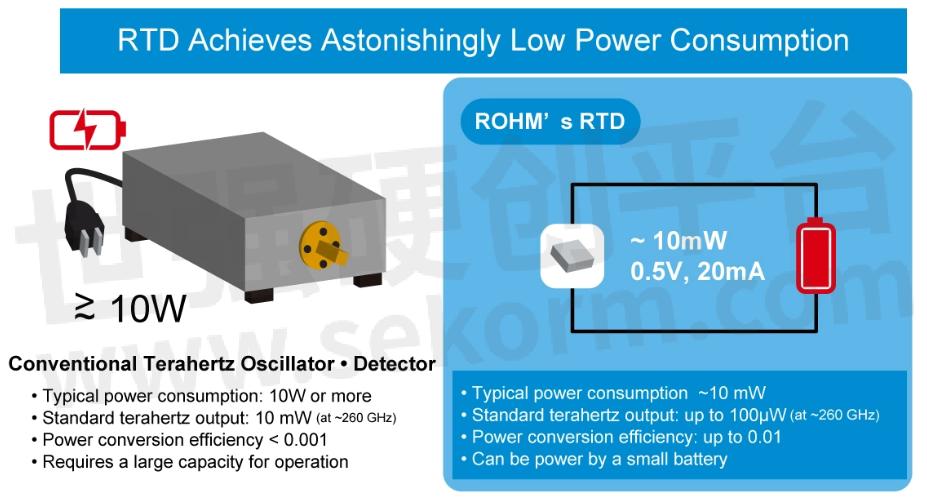
In ROHM's newly launched technical support forum, ‘Engineer Social Hub™' (Japanese only), engineers are actively discussing the development of terahertz applications using RTD. We invite you to join and participate.
*Engineer Social Hub™ is a trademark or registered trademark of ROHM Co., Ltd.
c) Provides a Low-Cost Development Environment
While the potential of terahertz waves is vast, significant barriers remain to their practical application. A major hurdle is the substantial development costs. Research and development in this field have historically been exorbitant, with terahertz measurement systems often costing millions or even tens of millions of yen, depending on the complexity of the application. The unexplored nature of this frequency band also adds to the risk, making it challenging to predict practical applications and commercial viability.
To address these issues and accelerate the practical use of terahertz waves, ROHM is lending RTD demo kits (subject to certain conditions) to engineers eager to develop groundbreaking applications that will revolutionize society.
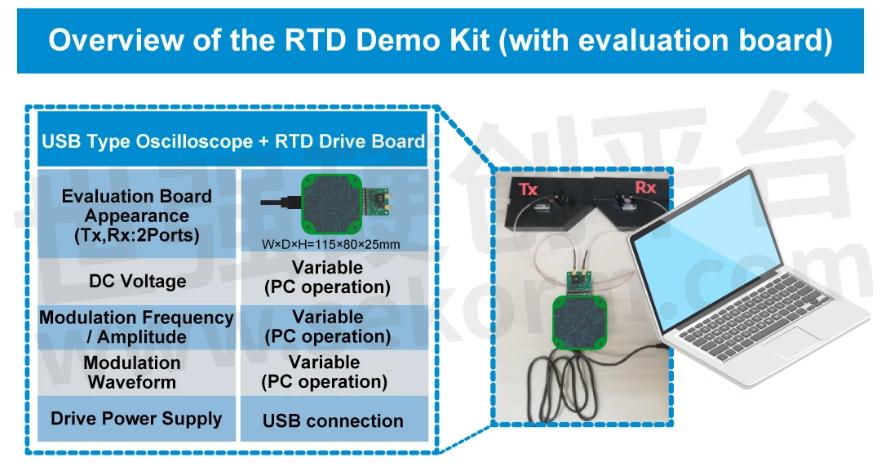
The demo kit will allow users to conduct research and development of terahertz wave application systems more easily and at a fraction of the cost. It has the potential to reduce development expenses by a factor of 10 or even 100.
The global race towards the practical application of terahertz is underway, with Japanese engineers reportedly at the forefront. ROHM is committed to leveraging this advantage to create a new wave of frequency bands from Japan, with the goal of early implementation in society.
d) Radio Law Compliance
As a relatively uncharted area, the legal framework for the terahertz band is still undergoing regulatory development. In Japan, it falls under the classification of radio waves, mandating that research and development adhere to the Radio Law. This imposes various constraints, such as the need for a radio station license and specialized high-frequency equipment, to conduct R&D and experiments on electromagnetic wave propagation, particularly for frequencies below 3THz.
ROHM is actively working to comply with both Japan's Radio Law and international standards to achieve early implementation of terahertz waves.
e) Future Development Plans
We plan to pursue research and development in two directions. The first is to further improve the output using array elements and expand the diversity of oscillation frequencies. The second is to achieve greater miniaturization while increasing efficiency. Expanding our lineup will contribute to the development of a variety of applications.

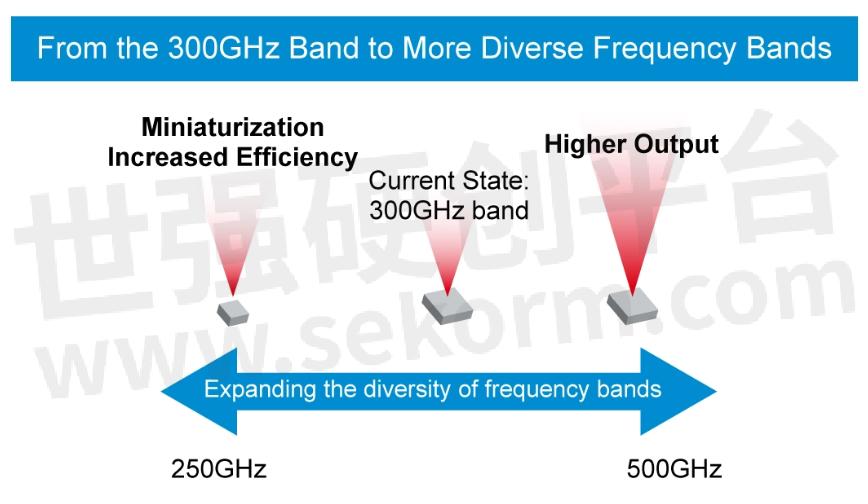
3. ROHM’s Challenges: From Manufacturing to Creating Value
ROHM's RTD has reached the stage of practical application after over a decade of dedicated research and development. By designing and manufacturing RTDs using proprietary technologies, ROHM has finally overcome the challenges that have hindered the practical use of terahertz waves. The result is an ultra-compact, low power terahertz oscillation device the size of an LED element. To facilitate development and reduce costs, ROHM is also offering RTD demo kits for loan (certain conditions apply).
Primarily an electronic device manufacturer, ROHM is seeking ways to unlock the full potential of this technology. Questions inevitably arise, such as, ‘What specific applications can benefit from RTD integration, and how can it be effectively utilized? To harness the previously unexplored terahertz band for the benefit of society and carry out value creation, we need partners willing to take on this challenge together.
While the RTD holds immense potential, a definitive, a killer application has yet to emerge. At the same time, the current technology requires further refinement to fully meet the needs and goals of developers as we work towards social implementation.
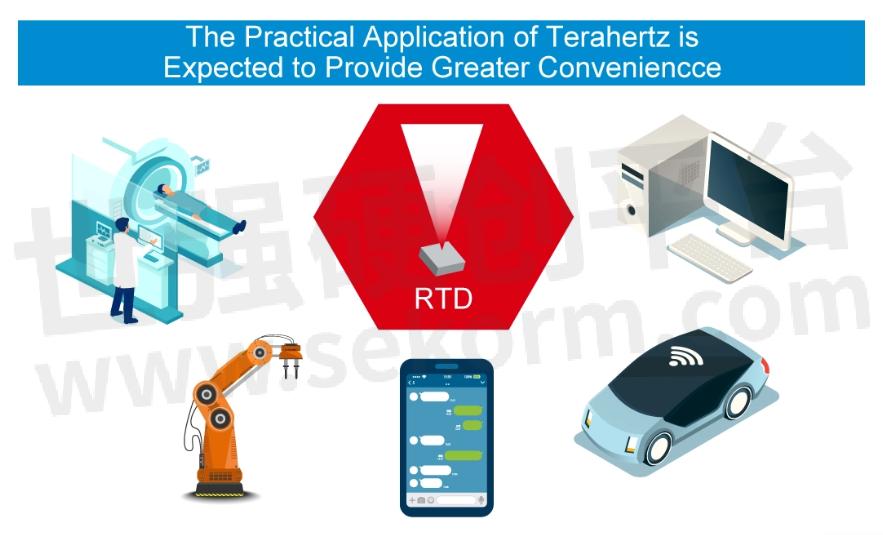
4. Pioneering the Final Frequency Frontier
The terahertz field holds significant development potential, with a wide range of applications yet to be explored. While ROHM believes that its proprietary RTD technology will significantly contribute to the advancement of the terahertz industry, we understand that engineers involved in application development may have questions or concerns beyond those discussed here.
As such, we welcome any feedback, including any challenges and issues you may encounter. Join ROHM in exploring terahertz waves – the final frequency frontier.
To foster collaboration and speed up innovation, ROHM has launched a new technical support forum called ‘Engineer Social Hub™' (Japanese only) that provides a space for engineers to connect, discuss, and exchange ideas, with the goal of pioneering the practical implementation of terahertz waves. We encourage active participation, as this platform offers valuable insights and inspiration for those working on terahertz application development.
- +1 Like
- Add to Favorites
Recommend
This document is provided by Sekorm Platform for VIP exclusive service. The copyright is owned by Sekorm. Without authorization, any medias, websites or individual are not allowed to reprint. When authorizing the reprint, the link of www.sekorm.com must be indicated.






















































































































































































































































































































































































































































































































































































































































































































































































































































































































